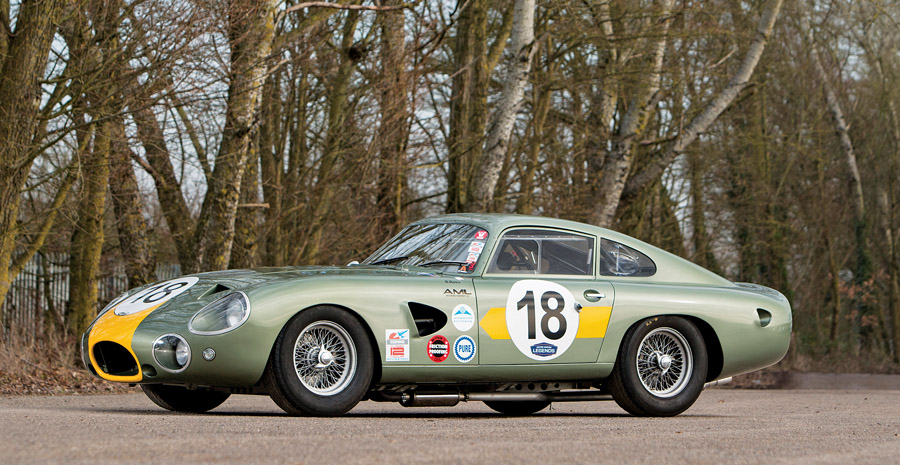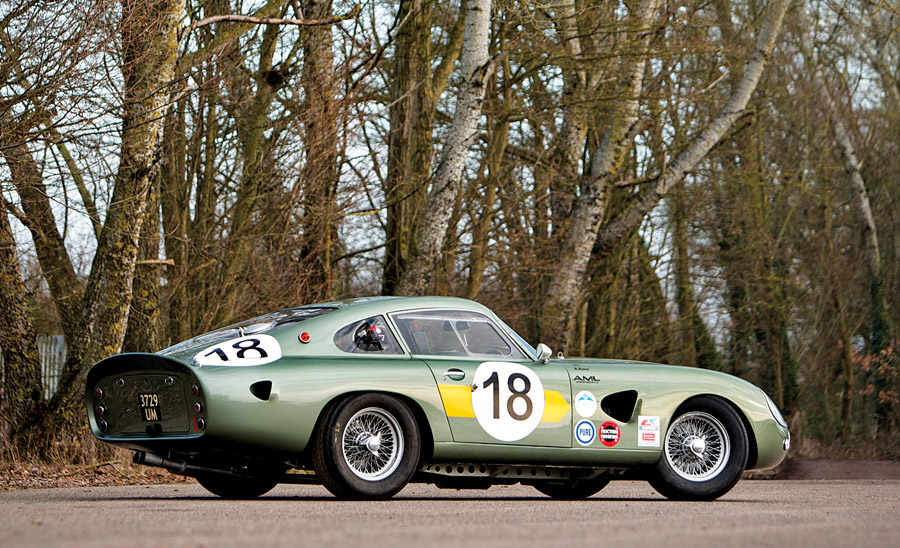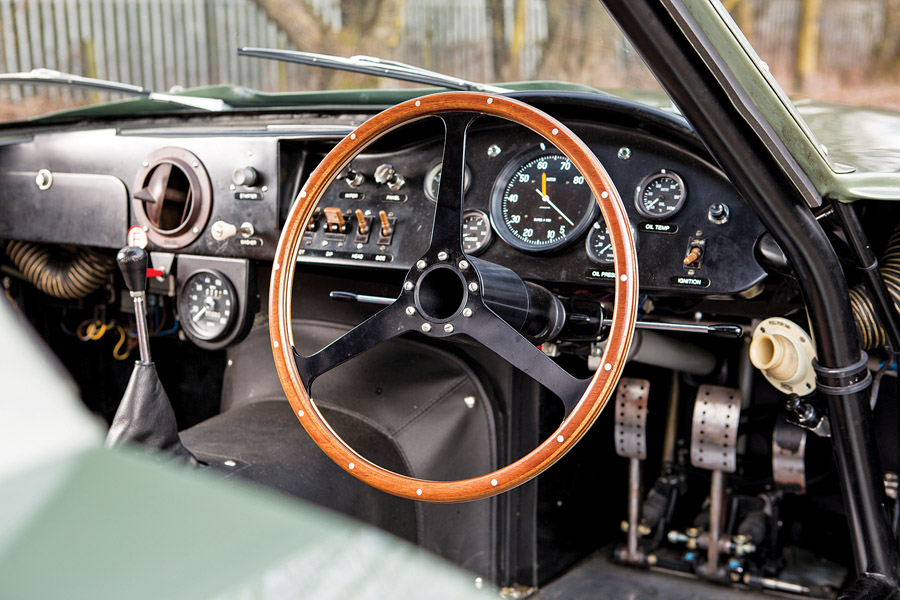SCM Analysis
Detailing
| Vehicle: | 1961 Aston Martin DP214 Replica Competition Coupe |
| Years Produced: | 1963 |
| Number Produced: | Two original DP214 cars. One still exists. There are three replica DP214 cars that were built from 1991 to 2010 |
| Original List Price: | N/A |
| SCM Valuation: | $711,050 (for the replica) |
| Chassis Number Location: | Plaque on right front of engine compartment |
| Engine Number Location: | Plaque on right front of engine compartment |
| Club Info: | Aston Martin Owners Club |
| Website: | http://www.amocna.org |
| Alternatives: | 1963 Jaguar “Semi-Lightweight” E-type, 1959–62 Ferrari 250 SWB replica, 1963 Ferrari 250 GTO replica |
| Investment Grade: | B (the original DP214 is an A) |
This car, Lot 38, sold for $681,866, including buyer’s premium, at Bonhams’ Goodwood Members’ Meeting Auction on March 19, 2017.
Although it was originally formed in 1913, the Aston Martin that we know today began in 1947. David Brown, scion of an industrial empire, saw an ad in the London Times. It offered a “sports car company” that turned out to be Aston Martin for sale. There was not much there but a name and a few engineers, but Brown thought it would be fun and purchased it personally for £20,000. A few months later, he made a similar deal for the remnants of the Lagonda Company. The 42-year-old Brown approached the whole thing as a lark and vanity project, with the idea of using it to go racing.
Along with Aston Martin came a tubular prototype chassis called the Atom. It didn’t meet Brown’s expectations for a racer but it was entered in the 1948 24 Hours of Spa anyway.
It won outright, and the post-war Aston racing tradition was cast.
Win on Sunday, Sell on Monday
For Le Mans in 1949, the Atom chassis (now considered the DB1) was mated with the Lagonda engine and alloy coupe bodywork to create the DB2.
The car didn’t do well at Le Mans, but it did very well a month later at Spa, and the success prompted the decision to put the DB2 into production. The factory did very well at Le Mans in 1950, with DB2s taking 1st and 2nd in class and winning the Index of Performance. Customers started buying the road DB2s.
David Brown had a viable sporting-car manufacturer on his hands.
Through the 1950s, Aston was on a roll: Between David Brown’s enthusiasm and the success of the “win on Sunday, sell on Monday” marketing approach, Aston became a worthy and effective competitor to Jaguar as Britain’s premier auto racing company.
The DB2 was followed by the DB2/4, then the DB2/4 Mk III, and in 1958, the DB4. World championship racing quickly moved away from closed road-type cars towards open sports cars, so Aston followed.
In 1951, the DB3 — an open racer — was introduced to compete with the Jaguar XK 120 and C-type. The DB3 proved heavy and clumsy and was replaced in 1953 with the DB3S, which was very successful for a number of years — and kept Aston Martin very much in the racing spotlight.
1956 saw the introduction of the DBR1, a new and much more sophisticated pure racer that proved very effective. The car evolved over the next few years — until Aston Martin achieved its goal and won Le Mans overall with the DBR1 in 1959.
With that accomplishment in hand, Aston sort of took a deep breath and sat back. Much had changed: They were selling lots of high-end sporting cars and the ethos of endurance racing was moving back to GT cars from sports racers. For the next few years Aston toyed (unsuccessfully) with Formula One and pretty much left the GT racing to private customers.
Back to GT racing
The GT racing circus was getting very intense during this period. The FIA had announced that starting in 1962, the World Championship would be contested in GT cars, so the serious players all upgraded their offerings in anticipation of the new rules. Ferrari had introduced the new 250 SWB, Jaguar introduced the E-type, and Aston Martin shortened and lightened its DB4 into the racing-oriented DB4GT, which was in turn further lightened with a Zagato body.
In 1961 Ferrari, Jaguar and Aston Martin seemed well matched, but the big show was opening in 1962, and Aston was worried; their cars were fast but still too heavy.
Having more or less abandoned Le Mans for a few years, Aston was under serious pressure from its dealers to get back into the game for the publicity and sales that it could generate. Thus, the Development Project (DP) cars were born.
Le Mans rules for 1962 included a non-production “Experimental” class, so Aston’s racing department took a DB4GT platform chassis, lightened it as much as possible, stuck in a 3.7-liter engine, built a lightweight, highly aerodynamic body, and called it DP212. It was still way too heavy to match Ferrari’s GTO and didn’t do well, but the concept seemed to work, and Aston decided to do a much better job for 1963.
Ferrari’s GTO was homologated as a “special bodied” SWB to meet the production rules — even though it shared little beyond engine, drivetrain and suspension with the SWB. It was 450 pounds lighter.
In this way, Ferrari established that the FIA wasn’t going to look very closely at the competitors, so Aston decided to go down the same path.
Enter the DP214
Aston created three chassis with an ultra-light box section tube frame and an improved version of the DP212 body design. Two were designated DP214 and got 3.7-liter DB4 engines and mechanicals to run as “production” GTs (they even got production DB4GT chassis numbers) while the third got a 4-liter dry-sump engine and transaxle to run in the (now) Prototype class, designated DP215. They were 700 pounds lighter than a DB4GT, roughly the same weight as the GTO.
The three cars were entered at Le Mans for 1963 with high hopes, but it was not to be: The two “GT” 214s went out with piston failure and the 215 broke its transaxle. Aston entered a few more races later in the year with moderate success — but sold everything off at the end of the year and quit racing.
One of the 214s was destroyed after it rolled at Nürburgring, killing its owner, so there are three “real” Project Astons left in the world: DP212, DP214 and DP215. They were and still are Aston Martin’s GTO, stunningly beautiful, fast, important — and rare to the point of being impossible to own or race.
Vintage racing and replica cars
It is time to consider an interesting conundrum when it comes to the issue of “replica” automobiles. Virtually all purists sniff and stiffen their backs at the idea of fiberglass Cobras or Ferrari clones mounted on 240Z chassis, but how should we approach extremely accurate re-creations of cars that are so rare and have become so valuable that they have effectively ceased to exist in the normal world?
Forty years ago, a person attending any national-level vintage race could legitimately expect to see and hear the absolute best of racing cars from the glory years — Ferraris, pre- and post-war Maseratis and Alfas, racing Aston Martins, and the like.
Moderately lucky and/or committed enthusiasts could still own and experience the greatness they represented (heck, even I was able to own and race a Ferrari TRC for a few years back then). Those times are gone, and the great cars are hen’s-teeth rare at all but a few of the most important races. If a re-creation of a great car is extremely correct and accurate, is there any reason to deny both an owner and the audience the experience that they represent?
It’s a difficult question.
The FIA, which controls the ability of cars to participate in international racing, has chosen not to take sides. Their required Historic Technical Passport certifies only that a given car is correct in all details — not that it is original. Thus a correct re-creation of a racing car is legal to race in their events; it is the organizer’s responsibility to choose who is welcome.
In the case of Aston’s beautiful and important DP214, there is only one real one, and it seldom, if ever, races, so the promoter’s choice is a good re-creation or nothing. So the three existing replicas are generally welcome whenever they want to show up.
They are still replicas, though, and they won’t ever carry the value of the originals. Right now $600,000–$700,000 seems to be both the standard and the limit for any really good replica, be it a GTO, SWB, TR or Aston DP214.
It may well be that this represents the underlying “weapons-grade” value of important racing cars. Anything above that is collector value. At about 5% of the value of a “real” car, the price for the experience without the status seems a rational decision for someone who mostly wants to race one. It’s a lot of bang for the buck. This car was fairly bought. ♦
(Introductory description courtesy of Bonhams.)


